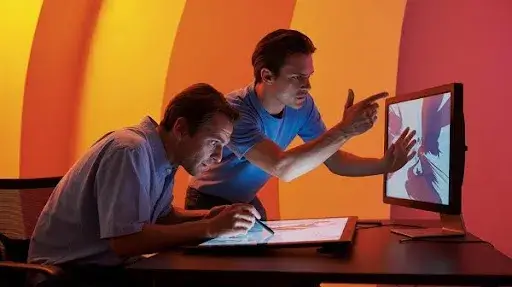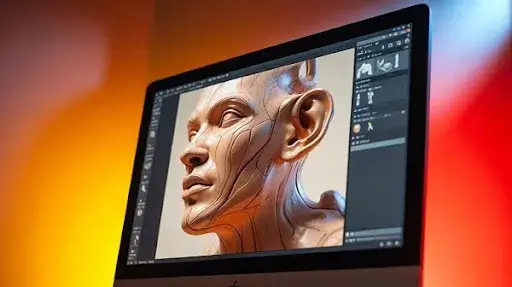Motion graphics aren’t just flashy visuals. They’re powerful tools that can turn complex ideas into clear, engaging stories. Businesses that once relied on static graphics or long live-action videos are now shifting toward animated motion graphics because they communicate faster, cost less, and stick in the mind longer.
If you’re planning a campaign, explainer video, or product launch, you need inspiration that shows how motion graphics can work in real life.
That’s exactly what this guide is about—showcasing some of the best motion graphics examples out there, explaining why they work, and pointing out what you can learn from them for your next project.
Benefits of Motion Graphics Animation
Motion graphics animation isn’t only about making things look good. It’s about making content useful, memorable, and easy to share. Here are a few benefits of motion graphics animation that brands rely on:
- Simplifies complex ideas: Motion graphics break down tough topics into visuals anyone can understand.
- Boosts engagement: People are more likely to watch a short animated video than read a long text.
- Consistent branding: You can carry your colors, fonts, and style across every animated video.
- Cost efficiency: Compared to shooting live-action with sets, actors, and locations, animated motion graphics videos are budget-friendly.
- Multi-purpose use: From social media ads to presentations, the same video can be reused across platforms.
These benefits explain why more companies are adding animated motion graphics videos into their marketing mix.
Top Motion Graphics Examples Worth Studying
Here’s a look at some of the finest motion graphics video examples that have inspired companies across industries. Each one shows a different approach you can use for your brand.
1. Slack – Clear and Simple Storytelling
Slack built one of the best motion graphics videos by keeping things stripped down. The animation used basic shapes, a limited color palette, and minimal text. Instead of overwhelming viewers, it stayed focused on clarity.
The sound design was a quiet hero in this piece—subtle effects matched each movement on screen. That balance of visuals and audio made the video stick in the audience’s memory.
Lesson: Sometimes less really is more. If you’re explaining a feature or process, start with clarity before creativity.
2. Reddit Mobile App – Fun and Engaging
When Reddit introduced its mobile app, it didn’t play it safe. It went with a colorful, humorous, and fast-paced promotional animated motion graphics video. The quirky illustrations reflected the playful energy of the platform itself.
It worked because it matched brand personality with animation style. That kind of consistency builds trust.
Lesson: Don’t be afraid to let personality shine through motion graphics. Humor, color, or bold visuals can all be part of your toolkit.
3. Cisco Secure Client – Abstract Yet Informative
Cisco created an animated motion graphics video that explained security concepts without drowning people in jargon. It used abstract shapes and synchronized movement with voiceover, which made complicated topics easy to understand.
Lesson: When your subject is heavy, lighten it visually. Use metaphors, abstract elements, and flowing transitions to keep the audience watching.
4. Airbnb’s Bélo – Storytelling Through Symbols
Airbnb’s Bélo motion graphics example wasn’t about selling features. It was about explaining the meaning of a logo. The video used simple moving shapes to tell a heartfelt story about belonging and connection.
Lesson: Animated motion graphics can carry emotion just as well as they carry information. If your brand is about values or vision, animation can bring that to life.
5. DigitalOcean – Short and Impactful
DigitalOcean showed that motion graphics don’t have to be long to be effective. Their video was under a minute yet packed with energy. Vibrant colors, geometric shapes, and upbeat narration kept the pace sharp.
Lesson: Brevity works. Short animated motion graphics videos can grab attention on social platforms where audiences scroll fast.
6. The Rise of Bitcoin – Explaining Complexity
Cryptocurrency can confuse even tech-savvy audiences. The Rise of Bitcoin video broke it down in under two minutes using charming illustrations and easy-to-follow motion graphics.
Lesson: Animated motion graphics are perfect for industries like finance, medicine, or software—areas where complexity is a barrier.
Types of Motion Graphics You Can Use
Not every motion graphics video looks the same. Depending on your brand needs, here are the types of motion graphics that can deliver results:
Animated Logos
A logo that moves sticks in memory better than one that doesn’t. Many companies now add short animated logo stings at the start or end of videos.
Kinetic Typography
This is animated text that moves, stretches, or fades to emphasize key points. Great for social media ads or music-driven content.
Infographic Animation
Instead of static charts, animated infographics show data coming to life. They keep audiences engaged longer than a flat graph.
Explainer Videos
Perhaps the most popular type. These videos break down how a product or service works. They often combine text, voiceover, and animated illustrations.
Product Demos
A slick way to highlight app features, software interfaces, or digital tools without needing live-action recording.
Animated Presentations
Adding motion to slides or decks makes even internal communication more engaging.
Great Motion Graphic Examples Across Industries
Finance: PayPal – Minimal Yet Memorable
PayPal’s motion graphics kept things sleek and minimal. Outlines, smooth transitions, and no unnecessary clutter. The simplicity fit the brand’s identity.
Takeaway: If your brand thrives on trust and clarity, minimal design can send a strong message.
Education: UEFA Nations League Explained
UEFA created a motion graphics video that explained tournament rules in a way even casual fans could understand. It turned something confusing into something simple with music, animation, and narration.
Takeaway: Educational content can benefit massively from motion graphics. If your product involves tutorials, this is the way to go.
Healthcare: Dr. Bill – Simplifying Billing
Medical billing isn’t exactly fun, but Dr. Bill’s motion graphics video made it understandable. Bright visuals turned a complex system into a simple explanation.
Takeaway: Even industries seen as “dry” can use motion graphics to humanize their message.
Blockchain: Blockdaemon – Clean and Professional
Blockdaemon’s video stood out with clean visuals and a structured flow. It explained blockchain infrastructure without losing the audience.
Takeaway: For B2B brands, a professional animated motion graphics video can present authority while staying watchable.
Lifestyle: American Express – Lively and Relatable
Amex used a dynamic mix of 2D animation services and 3D to show how credit card benefits touch different parts of life. It was less about numbers and more about possibilities.
Takeaway: If your service has broad uses, motion graphics can show lifestyle moments that connect with audiences emotionally.
Motion Graphics in Marketing Campaigns
The best thing about motion graphics? They travel well. You don’t have to retire an idea after one use. That quick reel on Instagram? With some tweaking, it becomes a longer explainer on YouTube. Chop it down, and it loops on TikTok. Same story—different outfit.
Marketers love that kind of flexibility. Live-action shoots, while impressive, are a headache: actors, locations, lighting issues, and the budget burn that comes with them. Motion graphics dodge all of that. Once you’ve built a design system, you can stretch or shrink it as needed.
Take Spotify’s “Wrapped.” On paper, it’s just stats—minutes streamed, top songs, favorite artists. But the motion design makes it personal. Text moves, colors pop, transitions feel alive. It turns cold data into a story people actually want to share. Millions do, without being asked.
The point is simple: build once, repurpose everywhere.
2D vs. 3D Motion Graphics
Every creative team hits the same fork: stick with 2D, or push into 3D?
2D has the advantage of speed. It’s direct, cost-friendly, and great for explaining things without fluff. Training videos, app demos, or walkthroughs usually live here.
3D, though, brings drama. Think of Apple’s product launches—the new phone spins in space like you could reach out and grab it. Or car commercials, where cameras swoop through the engine. It looks incredible, but it also costs time and money.
Brands lean into whichever suits them. Mailchimp favors quirky 2D because it matches their playful personality. Apple uses sleek 3D to highlight design precision. Neither is the “right” answer—it depends on what you want the audience to feel.
For speed and clarity, go 2D. For spectacle and immersion, go 3D.
Motion Graphics on Social Media
Social feeds move fast. Static posts get skipped. Add a bit of motion, though, and people pause.
Headspace is a great example. Their animations are minimal—circles that expand and contract, soft shapes that move slowly. They don’t just describe meditation, they feel like it.
Small brands can pull this off too. A café could animate steam from a coffee cup. A trainer might loop a stretch guide. A bookstore could show a book flipping pages by itself. None of this needs a Hollywood studio—just creativity.
And sometimes short is stronger. A five-second loop often performs better than a five-minute video.
Explainers Made Simple
Explainers are where motion graphics shine brightest. Live-action explainer attempts? Usually awkward. Actors pretending to use apps, clunky props—it rarely works.
Animation makes it painless. Dropbox proved that years ago. Their short animated explainer about “the cloud” helped people get it instantly, and it fueled their growth.
HubSpot uses the same approach today. Their explainers break down complex sales funnels and marketing systems into clips anyone can follow. The visuals stick in your head long after the video ends.
That’s the real power—explainers don’t just inform, they make people remember.
Branding That Moves
Brand identity doesn’t have to sit still. Once you animate it, the brand feels alive.
Nike shows how it’s done. Their swoosh isn’t static—it moves like an athlete: stretching, swiping, pulsing. You don’t just see it; you feel it.
Startups can do this too. Animate a logo sting for YouTube, add transitions in slide decks, or create looping reveals for social. These touches make a brand feel polished, even on a small budget.
Static branding is structure. Motion branding is personality.
Motion Graphics for Internal Communication
It’s not just for customers—motion graphics work inside companies too.
Onboarding is a prime example. Instead of a thick manual, imagine a three-minute animated guide. Google does this, and new hires absorb info faster.
The same goes for policy updates or training refreshers. People tune out when faced with long PDFs. But short animated explainers? They actually get watched.
Employees are an audience. Treat them like one, and they’ll engage.
Frequently Asked Questions
How are motion graphics different from animation overall?
Animation is broad—everything from Pixar films to claymation. Motion graphics focus on text, shapes, and design built to explain or persuade.
How long does it take to make one?
Depends. A simple 2D project might take a week. A polished 3D campaign could stretch into weeks.
Is 2D “serious” enough for large brands?
Definitely. Spotify, Slack, and Mailchimp all rely on 2D for digital campaigns.
Do B2B companies benefit?
Yes. Finance, tech, healthcare—motion graphics simplify topics that might otherwise confuse people.
What about cost?
Costs vary. Short 2D pieces are usually affordable. Detailed 3D campaigns require bigger budgets.
Final Words
Motion graphics aren’t extras—they’re tools. They explain, persuade, and stick in people’s minds.
The simple breakdown:
- Choose 2D for speed and clarity.
- Choose 3D for impact and realism.
And you don’t need to start big. Try a logo reveal, a looping social clip, or a short explainer. Once you see the results, static graphics won’t feel enough anymore.
Prolific Studio, one of the best animation studios in Los Angeles, provides top-notch motion graphics services to businesses of all sizes. Contact now and get expert consultation today.







